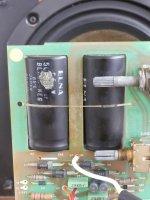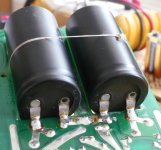If you can't locate 50V replacements, then it may help your search to add in 40V as an alternative. But you have to check first to find what voltage is suitable.sorry AndrewT I think we may be at cross purposes - what is there originally are two ELNA 50V 6800uF black caps that I read somewhere wer of the slit foil type, I cant find a liek for like replacement online. Bur I found these: ST2-010: 10000uF 80V Supertech 2T Slit Foil Capacitor | Hifi Collective and was wondering if they might be ok. I have since read that it may not be a good thing to go messing around with these cap values .. open to opinions - but now thinking i should just go for a good quality (whatever that means) 50V 6800uF -again open to opinions.
cheers
Rob
He needs to measure and calculate the worst case voltage that can form on the smoothing capacitors.You would probably be OK with 35V reservoir caps. The 22.5V AC rectifies out to about 32V DC.
A 240:22.5+22.5Vac 3% regulation transformer running on 253Vac will output 48.9Vac into the rectifier.
Taking off 1V for a single bridge leaves 34.0Vdc on the smoothing capacitors.
If that is the worst case, then 35V caps are OK.
But he must confirm tolerances by measurement.
BTW the split foil thing is not essential by any means. It's not like the voltage spec. It is a subtle modification to do with the current flow in the aluminium within the cap and is of debatable benefit in your Cyrus 1. 🙂
thanks JC,Traderbam, O2GF74 and Mark, really useful.
For ref my 6800 caps are 30mm Diameter and 60mm long - pix attached.
Looked up the KEMET info that Mark mentions HERE.
Looks like they are only available in 10000uF capacity - the 50V is ALC10S1102DF dims: 35mm x 50mm so 5mm extra diameter and 10000uF not 6800. Can I find the 50V available online anywhere ? nope!! Next closest is the 63V 10000uF - ALC10S1103DH which at 35mm by 60mm will fit.
This component is listed by mouser as a "call for a quote item". Which I will do. Also found stuff advertised as BHC (now keymet) Slit Foil Electrolytics (63V 10000uF) at hificollective.co.uk and hifituning24.de -Also found these at dnm.co.uk - which appear to be different ..
I wonder if anyone else knows of any other suppliers of slit foil type caps ?
I'm never ever keen about deviating from original specs - and I find myself still wondering what, if any, might be the effect of increasing the voltage rating and/or the capacity of the resevoir/smoothing capacitors ?
cheers all
For ref my 6800 caps are 30mm Diameter and 60mm long - pix attached.
Looked up the KEMET info that Mark mentions HERE.
Looks like they are only available in 10000uF capacity - the 50V is ALC10S1102DF dims: 35mm x 50mm so 5mm extra diameter and 10000uF not 6800. Can I find the 50V available online anywhere ? nope!! Next closest is the 63V 10000uF - ALC10S1103DH which at 35mm by 60mm will fit.
This component is listed by mouser as a "call for a quote item". Which I will do. Also found stuff advertised as BHC (now keymet) Slit Foil Electrolytics (63V 10000uF) at hificollective.co.uk and hifituning24.de -Also found these at dnm.co.uk - which appear to be different ..
I wonder if anyone else knows of any other suppliers of slit foil type caps ?
I'm never ever keen about deviating from original specs - and I find myself still wondering what, if any, might be the effect of increasing the voltage rating and/or the capacity of the resevoir/smoothing capacitors ?
cheers all
Attachments
Heh, those are just regular caps, not slit-foil/T-network types. Just use good quality electrolytics that will fit!
Well I learnt something, I guess you've seen this
Slit-foil Capacitors & T-Network Capacitors
The power supply capacitors are not in the audio signal path so will there be any noticeable difference?
Slit-foil Capacitors & T-Network Capacitors
The power supply capacitors are not in the audio signal path so will there be any noticeable difference?
The Power supply caps supply the current to the speaker.
They are in the audio path.
However, correctly sized and located MF and HF supply rail decoupling meet most of the upper frequency current demands of the speaker.
This leaves the PSU capacitors with an easy LF current supply duty.
Good decoupling allows any capacitor to perform adequately in the PSU.
They are in the audio path.
However, correctly sized and located MF and HF supply rail decoupling meet most of the upper frequency current demands of the speaker.
This leaves the PSU capacitors with an easy LF current supply duty.
Good decoupling allows any capacitor to perform adequately in the PSU.
The Power supply caps supply the current to the speaker.
They are in the audio path.
.
No they are not, and this could spark a whole new debate. You could say your neighbours fridge is in the signal path as it is connected by wires to the same mains supply as is your amp. . Where do you draw the line.
The speaker current does not come from your neighbour's fridge.No they are not, and this could spark a whole new debate. You could say your neighbours fridge is in the signal path as it is connected by wires to the same mains supply as is your amp. . Where do you draw the line.
So, there is no difference?Non-polar electrolytic are much bigger than bi-polar electrolytic for the same capacitance and voltage rating. This might not be true anymore.
Yes. They are the original capacitance, they will fit properly and are only 10mm shorter than the originals. The more metal the better. They have a high ripple current rating.Heh, those are just regular caps, not slit-foil/T-network types. Just use good quality electrolytics that will fit!
Last edited:
Where do you draw the line is always a dilemma in audio. Sellers of audio exotica try to persuade us to never draw a line.No they are not, and this could spark a whole new debate. You could say your neighbours fridge is in the signal path as it is connected by wires to the same mains supply as is your amp. . Where do you draw the line.
BTW the mains supply is only directly in the signal path for a few ms every cycle when the rectifier diodes conduct. It is arguably also constantly but indirectly in the signal path by magnetic induction from the transformer.
Last edited:
I sincerely hope it doesn'tNo they are not, and this could spark a whole new debate.
thanks JC - you know I wondered - I cnat remember what thread it was that mentioned split foil .. fools errand it would seem - but have learned a lot.
and thanks traderbam - will get on to those nichicons.
and thanks traderbam - will get on to those nichicons.
Last edited:
BTW the split foil thing is not essential by any means. It's not like the voltage spec. It is a subtle modification to do with the current flow in the aluminium within the cap and is of debatable benefit in your Cyrus 1. 🙂
...thx traderbam - Am I correct in my understanding that as long as I have a voltage rating that is the same as or above the original spec - then that will be ok ?
Or does the voltage spec affect the circuit in some way I am unaware of ?
thanks AndrewT and O2GF74 - yes, have seen that interesting page O2, only trouble is its made me want split foil caps .. for what I guess are probably miniscule gains in reproduction quality .. still, marginal gains and all that! ... I am aware that my refurb of this amp is purely driven by sentiment, I should probably be making something new, but I have grown used to its particular quality of sound over the years, its driven some great parties and is a family friend ! 🙂)
63V was deliberate. The higher the voltage spec the more metal and more ripple current. That Nichicon 63V happened to be the right diameter as well as being a compatible length....thx traderbam - Am I correct in my understanding that as long as I have a voltage rating that is the same as or above the original spec - then that will be ok ?
Or does the voltage spec affect the circuit in some way I am unaware of ?
Mission does use slit foils nowadays in their external psu's see PSX-R. whether that was done for HIFI reviewers to have something to write about or because of performance reasons such as mitigating added inductance due to ombilical or even to justify somehow the pice tag is anybody's guess. They are good caps nonetheless, if you can find them at the correct price and size i would personnaly use them, but they are not the only good caps. Stop agonising... AndrewT has a point about decoupling, not sure what space is available in your amp.
- Status
- Not open for further replies.
- Home
- Amplifiers
- Solid State
- Cyrus 1 refurb information and questions

